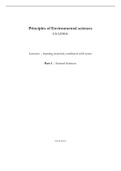Samenvatting
Summary Principles of Environmental Sciences - Natural Science
- Instelling
- Wageningen University (WUR)
The Lectures of Dr. Arnold van Vliet are summarized in this document. 1 Lecture roughly has 5 pages, including class notes, table of content and graphs. Chapters 1,2, 3, 5, 8, 9 of textbook included.
[Meer zien]




